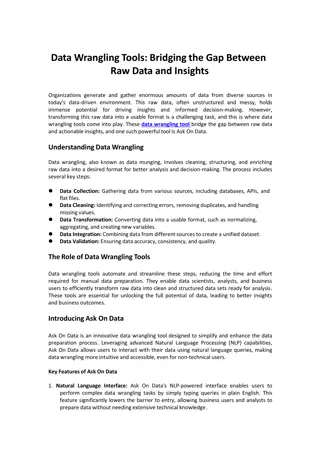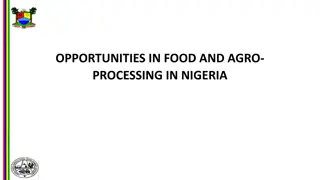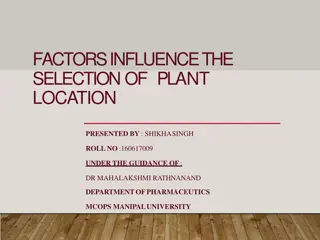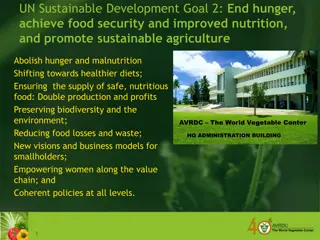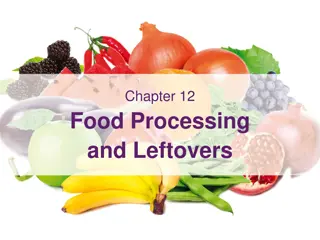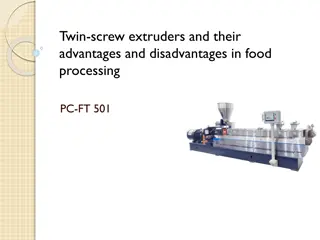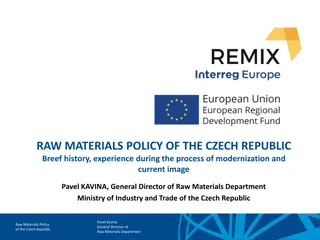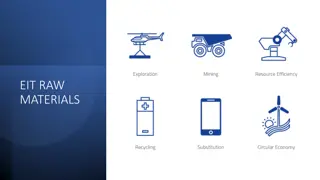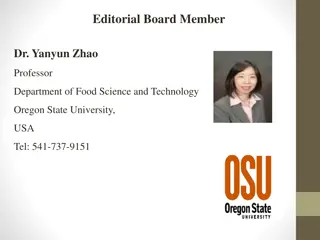Significance of Raw Materials in Food Processing
Effective selection of raw materials is crucial for ensuring the quality of processed food products. The quality of raw materials directly impacts the final products, making it important to procure materials that align closely with processing requirements. Quality evaluation, including microbiological aspects, water content, and specific parameters, plays a key role in determining the suitability of raw materials for different food processing applications. Collaboration between agriculture and processing facilities is essential to maintain high standards. Various processing methods, such as extrusion, fermentation, cooking, and pasteurization, are employed to transform raw agricultural products into consumable items.
Download Presentation

Please find below an Image/Link to download the presentation.
The content on the website is provided AS IS for your information and personal use only. It may not be sold, licensed, or shared on other websites without obtaining consent from the author. Download presentation by click this link. If you encounter any issues during the download, it is possible that the publisher has removed the file from their server.
E N D
Presentation Transcript
Raw materials and their significance in food processing
Introduction The selection of raw materials is a vital consideration to the quality of processed products. The quality of raw materials can rarely be improved during processing and, while sorting and grading operations can aid by removing oversize, undersize or poor quality units, it is vital to procure materials whose properties most closely match the requirements of the process. The quality of end products is influenced primarily by the raw materials used. For this reason, close cooperation between agriculture and processing plants is needed. The farmers, in many cases, make agreements with the food industry, not only on the quantity of raw materials produced, but above all on their quality. The quality of raw material is evaluated, and farmers are paid according to that quality (for example for wheat, milk, eggs, and so on). In all cases the raw material must fulfill all hygienic requirements. Great attention is paid to the presence of different kinds of contamination, such as heavy and toxic metals, toxic metabolites of microorganisms, residues of pesticides, the presence of GM material, and others.
In perishable raw materials, the microbiological quality of the raw material plays an important role and has to be controlled. The water content of many raw food materials has the biggest influence on its storability. The water content and weight during acceptance are closely followed. For quality control of individual raw materials, different quality parameters are chosen, according to the quality requirements of products for which the raw material will be used. For example, wheat quality, after water content, will be tested on the amount and bakery quality of gluten. For quality evaluation of fruits, in addition to their appearance, the content of ascorbic acid, sugar, and acidity is controlled. In meat especially the fat content is followed.
Food Processing Food preparation and processing can be defined as "any change that is made to a food to alter its eating quality or shelf life The transformation of raw agricultural products into semi-finished or finished products for consumption. Food Processing is the conversion of agricultural product to substances which have particular textural, sensory and nutritional properties using commercially feasible methods Extrusion (noodles, spaghetti) Fermentation-yeast, bacteria (yoghurt, beer, condiments) Cooking-boiling, frying, roasting, grilling, baking Pasteurization (milk, juice, canned foods)
Types of processing of food Primary processing This is the conversion of raw materials to food commodities. Milling is an example of primary processing. SECONDARY PROCESSING Secondary processing is the conversion of ingredients into edible products - this involves combining foods in a particular way to change properties. Baking cakes is an example of secondary processing
Raw materials properties The main raw material properties of importance to the processor are 1. Geometry 2. Colour 3. Texture 4. Functional properties 5. Flavour.
Geometric properties Food units of regular geometry are much easier to handle and are better suited to high speed mechanised operations. In addition, the more uniform the geometry of raw materials, the less rejection and waste will be produced during preparation operations such as peeling, trimming and slicing. For example, potatoes of smooth shape with few and shallow eyes are much easier to peel and wash mechanically than irregular units. Smooth-skinned fruits and vegetables are much easier to clean and are less likely to harbour insects or fungi than ribbed or irregular units
Colour Colour and colour uniformity are vital components of visual quality of fresh foods and play a major role in consumer choice. However, it may be less important in raw materials for processing. For low temperature processes such as chilling, freezing or freeze-drying, the colour changes little during processing, and thus the colour of the raw material is a good guide to suitability for processing. For more severe processing, the colour may change markedly during the process. Green vegetables, such as peas, spinach or green beans, on heating change colour from bright green to a dull olive green. This is due to the conversion of chlorophyll to pheophytin. It is possible to protect against this by addition of sodium bicarbonate to the cooking water, which raises the pH. However, this may cause softening of texture and the use of added colourants may be a more practical solution.
Texture The texture of raw materials is frequently changed during processing. Textural changes are caused by a wide variety of effects, including water loss, protein denaturation which may result in loss of water-holding capacity or coagulation, hydrolysis and solubilisation of proteins. Texture is dependent on the variety as well as the maturity of the raw material and may be assessed by sensory panels or commercial instruments. One widely recognised instrument is the tenderometer used to assess the firmness of peas. The crop would be tested daily and harvested at the optimum tenderometer reading.
Flavour Flavour is a rather subjective property which is difficult to quantify. Again, flavours are altered during processing and, following severe processing, the main flavours may be derived from additives. Hence, the lack of strong flavours may be the most important requirement. In fact, raw material flavour is often not a major determinant as long as the material imparts only those flavours which are characteristic of the food. Flavour is normally assessed by human tasters, although sometimes flavour can be linked to some analytical test, such as sugar/acid levels in fruits.
Functionality The functionality of a raw material is the combination of properties which determine product quality and process effectiveness. These properties differ greatly for different raw materials and processes, and may be measured by chemical analysis or process testing. For example, a number of possible parameters may be monitored in wheat. Wheat for different purposes may be selected according to protein content. Hard wheat with 11.5 14.0% protein is desirable for white bread and some whole wheat breads require even higher protein levels, 14 16%. Chemical analysis of fat and protein in milk may be carried out to determine its suitability for manufacturing cheese, yoghurt or cream.
Classes of raw materials 1. Unprocessed agricultural raw materials They are in their natural state e.g yam tuber, cassava, orange, grape, banana, maize grains, soybeans 2. Semi-processed agricultural raw material- These have undergone some preliminary processing e.g dried cocoa beans, malted grain, cassava chips, brown sugar, pasteurized milk 3. Finished products- These are outputs made from unprocessed and semi-processed agricultural raw material e.g refined sugar, flavor concentrates, flour, colouring agents etc. 4. By-products/Effluents of an industry- This serves as an input or raw material for another industry e.g fish gut used as feed
Raw Materials and Types Industry Materials processed Beef, lamb, pork, poultry Processing techniques Slaughtering, cutting up, boning, comminuting, cooking Heading, gutting, filleting, cooking Preserving techniques Salting, smoking, refrigeration, deep-freezing, sterilization Deep-freezing, drying, smoking, sterilization Sterilization, pasteurization, drying, dehydration, lyophilization (freeze drying) Drying cooking or baking Meat processing and preserving Fish processing All types of fish Fruit and vegetable preserving Fresh fruit and vegetables Blanching or cooking, grinding, vacuum- concentration of juices Milling Grains Grinding, sifting, milling, rolling
Baking Flour and other dry goods, water, oils Kneading, fermentation, laminating surface treatments of seasoning Baking, cutting surface treatments and packaging Biscuit making Flour, cream, Mixing, kneading, laminating moulding Baking, cutting surface treatments and packaging butter, sugar, fruit and seasoning Pasta manufacture Flour, eggs Kneading, grinding, cutting, extrusion or moulding Drying Sugar processing and refining Sugar beet, sugar cane Crushing, maceration, vacuum concentration, centrifuging, drying Vacuum cooking Chocolate making and confectionery Cocoa bean sugar, fats Roasting, grinding, mixing, conching, moulding -
Brewing Barley, hops Grain milling, malting, brewing, filter pressing, fermentation Distillation, blending, aeration Pasteurization Distilling and manufacture of other beverages Fruit, grain, carbonated water Pasteurization Milk and milk products processing Milk, sugar, other constituents Skimming, churning (butter), coagulation (cheese), ripening Pasteurization, sterilization or concentration, desiccation Processing of oils and fats Groundnuts, olives, dates, other fruit and grain, animal or vegetable fats Milling, solvent or steam extraction, filter pressing Pasteurization where necessary
Deterioration of raw materials All raw materials deteriorate following harvest, by some of the following mechanisms: Endogenous enzymes: oxidation of phenolic substances in plant tissues by phenolase (leading to browning), sugar-starch conversion by amylases Chemical changes: deterioration in sensory quality by lipid oxidation, non-enzymic browning, breakdown of pigments such as chlorophyll, anthocyanins, carotenoids. Nutritional changes: especially ascorbic acid breakdown. Physical changes: dehydration, moisture absorption. Biological changes: germination of seeds, sprouting. Microbiological contamination: both the organisms themselves and toxic products lead to deterioration of quality, as well as posing safety problems.
Damage to raw materials Damage may occur at any point from growing through to the final point of sale. It may arise through external or internal forces. External forces result in mechanical injury to fruits and vegetables, cereal grains, eggs and even bones in poultry. They occur due to severe handling as a result of careless manipulation, poor equipment design, incorrect containerisation and unsuitable mechanical handling equipment. The damage typically results from impact and abrasion between food units, or between food units and machinery surfaces and projections, excessive vibration or pressure from overlying material. Increased mechanisation in food handling must be carefully designed to minimise this. Internal forces arise from physical changes, such as variation in temperature and moisture content, and may result in skin cracks in fruits and vegetables, or stress cracks in cereals. Either form of damage leaves the material open to further biological or chemical damage, including enzymic browning of bruised tissue, or infestation of punctured surfaces by moulds and rots.
Treatment of raw materials (pre-processing operations) Cleaning Sorting Grading Dehulling Peeling Packaging Storage
Raw material cleaning Cleaning methods-dry cleaning methods, wet cleaning methods Dry cleaning methods- screening, abrasion cleaning, aspiration cleaning, magnetic cleaning, Wet cleaning methods- soaking, spray washing, flotation washing, See Handout on Cleaning of raw materials, Sorting and grading of foods
Sorting It is the separation of raw materials into categories based on weight, size, shape, colour It allows separation of undesirable additional materials e.g leaves, stones It allows removal of immature or rotten raw materials, ensuring only good quality material are passed into the processing line Size sorting separates solids into different fractions based on size by sieving or screening Size sorting is important for materials which have to be heated or cooled as differences in size can lead to under-processing or over- processing Sieves and screens used in size sorting can have fixed or variable appertures and may be stationary, rotating or vibrating
Grading It is an assessment of different characteristics of a food material to determine its overall quality It is usually carried out by trained operators (inspectors) and hence is more expensive than sorting Meat is graded for fat distribution, carcasse size, disease and shape Grading is sometimes based on laboratory analyses/results
Dehulling It involves the removal of hulls, seed coats, brans or shells from legumes, cereals, cocoa beans etc. It can be achieved via wet or dry method and its efficiency depends on the thickness of the seed coat Dehulling may be preceded by heating process to facilitate removal of the hull, known as conditioning
Peeling Peeling aims at removing unwanted or inedible materials from food raw materials It improves the appearance and taste of the final product During peeling, losses must be minimized by removing as little as possible of the underlying raw material Peeling can be achieved by steam peeling, knife peeling (citrus fruits), abrasion peeling (using abrasive rollers), caustic peeling (1-2% sodium hydroxide), flame peeling (using high temperatures) e.g for removing root hairs and skins of onions
Storage and transportation of raw materials Storage of food is necessary at all points of the food chain from raw materials, through manufacture, distribution, retailers and final purchasers. Today s consumers expect a much greater variety of products, including nonlocal materials, to be available throughout the year. Effective transportation and storage systems for raw materials are essential to meet this need. Storage of materials whose supply or demand fluctuate in a predictable manner, especially seasonal produce, is necessary to increase availability. It is essential that processors maintain stocks of raw materials, therefore storage is necessary to buffer demand. However, storage of raw materials is expensive for two reasons: firstly, stored goods have been paid for and may therefore tie up quantities of company money and, secondly, warehousing and storage space are expensive.
Spoilage arises through three mechanisms: living organisms such as vermin, insects, fungi and bacteria: these may feed on the food and contaminate it; biochemical activity within the food leading to quality reduction, such as: respiration in fruits and vegetables, staling of baked products, enzymic browning reactions, rancidity development in fatty food; physical processes, including damage due to pressure or poor handling, physical changes such as dehydration or crystallisation.
The main factors which govern the quality of stored foods are 1. Temperature 2. Moisture/humidity 3. Atmospheric composition
Temperature The rate of biochemical reactions is related to temperature, such that lower storage temperatures lead to slower degradation of foods by biochemical spoilage, as well as reduced growth of bacteria and fungi. For example, storage temperature affects the starch/sugar balance in potatoes: in particular below 10 C a build up of sugar occurs, which is most undesirable for fried products. Temperature of storage is limited by cost. Refrigerated storage is expensive, especially in hot countries. In practice, a balance must be struck incorporating cost, shelflife and risk of cold injury. Slower growing produce such as onions, garlic and potatoes can be successfully stored at ambient temperature and ventilated conditions in temperate climates. It is desirable to monitor temperature throughout raw material storage and distribution.
Humidity If the humidity of the storage environment exceeds the equilibrium relative humidity (ERH) of the food, the food will gain moisture during storage, and vice versa. Uptake of water during storage is associated with susceptibility to growth of microorganisms, whilst water loss results in economic loss and more specific problems, such as cracking of seed coats of cereals, or skins of fruits and vegetables. Ideally, the humidity of the store would equal the ERH of the food so that moisture is neither gained nor lost, but in practice a compromise may be necessary
Atmospheric composition Controlling the atmospheric composition during storage of many raw materials is beneficial. Packaging may be used to allow the development or maintenance of particular atmospheric compositions during storage With some materials, the major aim is to maintain an oxygen-free atmosphere to prevent oxidation, e.g. coffee, baked goods, while in other cases adequate ventilation may be necessary to prevent anaerobic fermentation leading to off flavours. In living produce, atmosphere control allows the possibility of slowing down metabolic processes, hence retarding respiration, ripening and the development of disorders.






